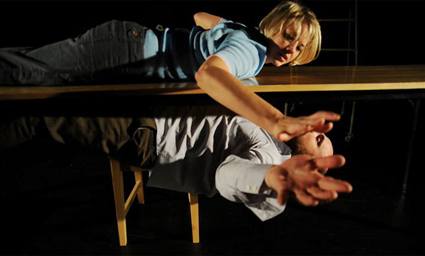relations de-fused
maggi phillips: fuse

STRUT, Fuse
photo Ash de Prazer
STRUT, Fuse
FUSE IGNITED IN STRAINED TENSION AS THE WOMAN (RHIANNON NEWTON) GEOMETRICALLY WHIPPED A FEW UTENSILS ACROSS AN OVERLY LONG, TAUTLY CLOTHED TABLE BEFORE RETURNING REPEATEDLY TO SIT AND WAIT. RESONANCES OF BECKETT AND HITCHCOCK PERMEATED A FUSION OF ORDINARINESS AND INCIPIENT VIOLENCE, THE SETTING PROMISING A KNOTTED EMOTIONAL TRAJECTORY ABOUT TO BE SERVED. HER TENSE STROKES CUT ACROSS THE ARRIVAL OF THE SUITOR (JONATHAN BUCKELS) OUT OF THE SHADOWS WITH SUITCASE AND CHAIR. EXPECTATIONS SHIFTED IN BECKETT’S DIRECTION: MAYBE AN ABSURDIST TALE HAD SLIPPED ONTO THE MENU?
Neither course was delivered that evening. Instead, as if entangled in invisible loops of tripwire, two individuals tackled objects with the might of their separate anxieties and desires, swivelling and swirling in a paired but never intimate journey. Absurdity flickered in emotional futility and glared over the materiality of objects. Instead of the awaited feast, he brings to the table a bag and a goldfish bowl (as well as the second chair) that revolved and collided throughout the piece along with plates, engagement ring, shelves and peanuts. The alternating anxiety and composure of table arrangement in the opening scene, potentially a significant dramatic trigger, was annulled when the second chair entered not to be placed at, but on the table, rearranging (as his presence must) the cloth and any simple expectation of exchange.
Fragmentary scenes succeeded one another like a compendium of random tests: the feast gave way to a peanut popping contest, in which she tops his skill set, before switching to a male dress-up of the woman as seductive object without any clear indication that the two might have been playing together. Was this a narrative stream of consciousness and, if so, whose? Whatever electricity that might have been generated by tablecloth pyrotechnics, when he imprisons her, and fishbowl ultimatums, when she threatens to drop the innocent fish on his head, is blown by a faulty relationship fuse. Myriad objects took focus, initiating inventive games, taunts and obsessions, played out by a couple who remain isolated ciphers in a venture bound towards dystopic inevitability.
Emotional vacuity may well have been the premise for the work except that Fuse’s midpoint sparked with nostalgia when Charles Aznavour crooned “Dance in the old-fashioned way” over a brief quickstep or two of union before the couple, with an affection not offered to one another at any other point, gave the floor over to an invited elderly partnership from the audience. The long anticipated circuit connection was eloquently embodied in this man and woman dancing together with an ease of companionship, bearing testimony to frictions overcome and wrought into genuine fusion. Old-fashioned love with all of its accompanying imperfections made an indelible impression and with such mesmerising simplicity that it was hard to resist reminiscing on faded sepia mementos of a lost past. Contemporary performance operates on a register where frustrations pervade both on-and-off modalities and deny durability and determined continuity. Having introduced this alternative moment, Newton and Buckels then make the technically efficient but dramatic error of setting up the next array of objects in the background. Or was that decision intentional: a way of subverting a stolen precious moment?
Any fuse which may have energised the work was blown when object logistics intervened, tripping desires for personal relationships with scepticism and clever (or otherwise) subversions. Happy endings are simply dead leads, forgotten under the morass of electronic cables and instruments of new social relations. The program notes suggest that Fuse explores the reciprocal issues of identity change in a love relationship. Physically, Newton and Buckels do convey, in moments, intriguing interaction, moving with a satisfying sense of oblique empowerment, but reciprocity is ever absent and objects, rather than people, construct the narrative current. Interactive physicality in Fuse mainly comes across in combative situations with, can it be said again, objects?
Post-Aznavour, violence predictably, took over. Incarceration within the tablecloth, with a knowing nod to Hitchcock, turns lurid and rape-like. What more can he do but bind her in domesticity, hang her on the same cloth under the up-turned table before collecting his material staples and departing? As with so much of the object manipulation in this work, the image of this woman, strung under the armpits by the same cloth which so consumed her attention at the beginning, could have carried devastating or poignant capital. Unfortunately, terror and/or empathy were de-fused by our simply not caring who she or he, as vulnerable individuals, might have been.
Fuse, concept, direction Jonathan Buckels, performers Jonathan Buckels, Rhiannon Newton, music director & DJ Travis Collins, lighting Mike Nanning, presented by STRUT Dance; PICA, Perth, Aug 26-Sept 3
RealTime issue #105 Oct-Nov 2011 pg. 20






